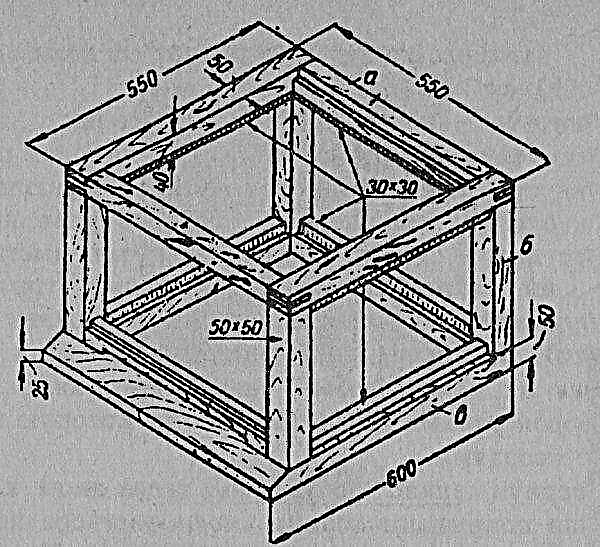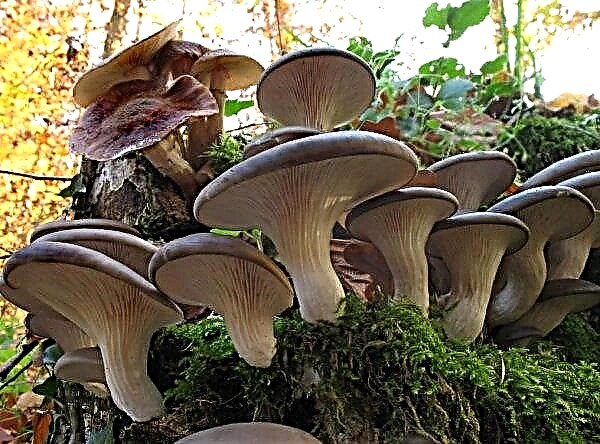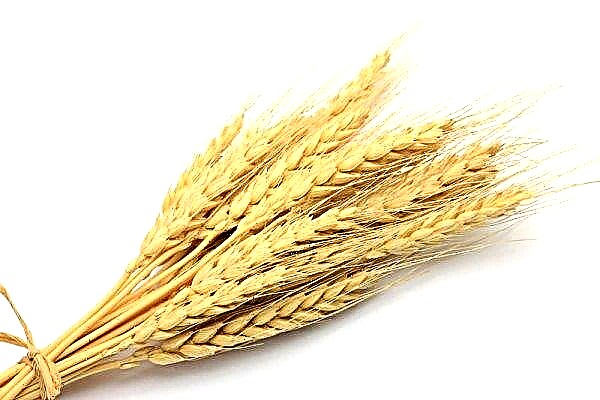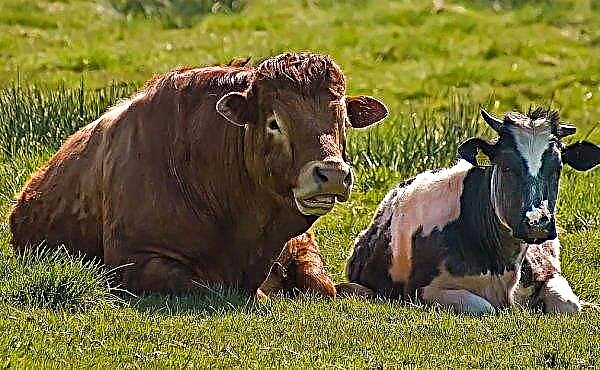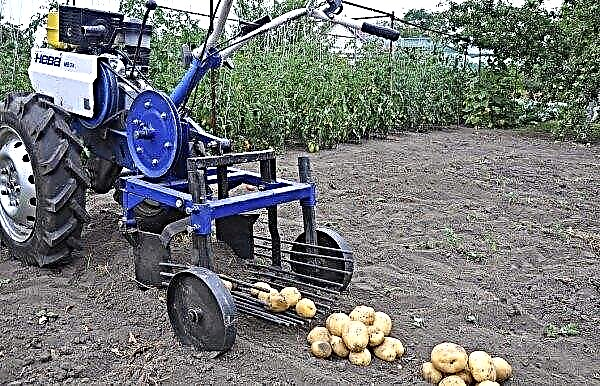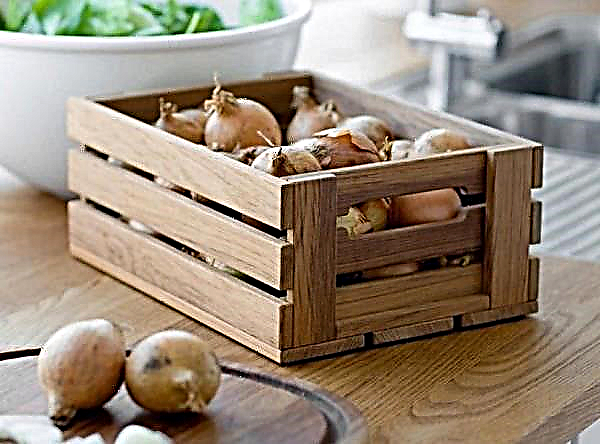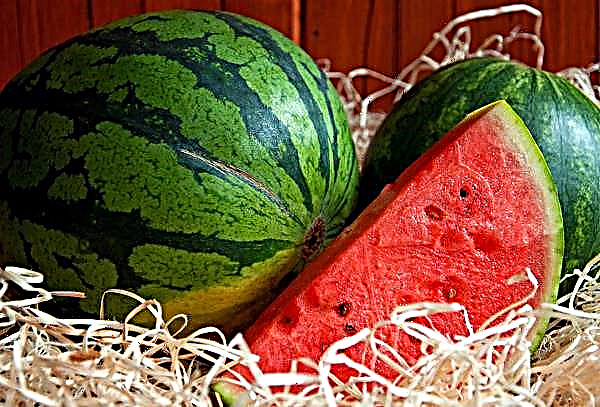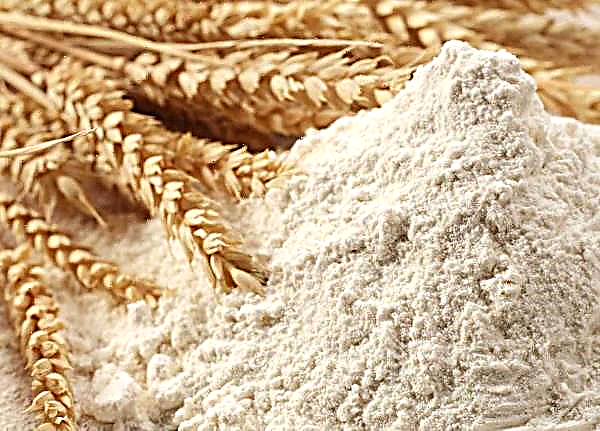Among the wide variety of tomato varieties that are grown in domestic gardens, the Dutch representative of Solanaceae, the Big Beef tomato, is notable for its excellent taste, strong immunity and impressive size. How to grow a tomato, and how to care for it after planting, let's figure it out.
Description of tomato variety
Big Beef Tomatoes are indeterminate (with unlimited growth), an early ripe, disease-resistant hybrid, whose homeland is the state with a warm and humid summer in Holland. This variety has the following characteristics:
- the bush is strong, powerful, can reach a height of up to 2 m. Due to its height, it needs mandatory garter and support;
- early ripe hybrid; fruit ripening period from the beginning of planting is 98–100 days;
- the plant requires the formation of 1 stalk and the removal of lateral shoots (small stepsons up to 3-4 cm);
- large tomato leaves, light green, with a small edge. Shoots - strong and strong, able to hold large, massive fruits;
- the inflorescence is simple, formed on 8-9 leaf;
- on one brush 4-5 fruits can ripen;
- the yield of the variety is quite high, from 1 m², under the conditions of proper agricultural technology, you can collect about 9 kg of tomato;
- the fruits are large, weighty, with a flat-round shape, have a traditional saturated bright red color, are capable of reaching a weight of up to 200-300 g. Some specimens grow up to 2 kg;
- the taste of fruits is pleasant, sweet with a slight acidity;
- the pulp is dense, juicy, fleshy;
- the peel of a tomato is shiny, thin, but resistant to cracking;
- suitable for fresh consumption, as well as for the preparation of ketchups, sauces, tomato paste and salad dressings for the winter.

Advantages and disadvantages of the variety
- Tomatoes "Big Beef F1" can boast a lot of advantages:
- early ripening;
- high resistance to almost all diseases affecting tomatoes, in particular late blight, nematode, fusarium, tobacco mosaic;
- resistance to environmental conditions, including low temperature indicators;
- excellent palatability of fruits, their transportability;
- with proper storage, the fruits do not lose their juiciness and nutrients for 3 weeks.
- Among the disadvantages of a tomato are:
- some difficulty in growing, because uncomfortable conditions adversely affect the yield of the plant;
- large sizes of fruits that are not suitable for salting and canning in a whole fruit form;
- the plant requires frequent top dressing;
- the inability to get seeds from hand-grown tomatoes, due to the fact that the variety is hybrid.
Features of planting and growing
Experts recommend growing this variety of tomatoes in greenhouses, since the ideal conditions for the ripening of the plant are: average temperature + 18 ° C and a fairly high humidity.
Important! On open ground, tomatoes are grown only in the southern regions, where a warm and humid climate prevails. The variety is adapted to certain conditions, therefore, it negatively tolerates sudden changes in temperature.
Optimal conditions
Optimal conditions in the greenhouse favorably affect the growth of the plant, the formation and development of fruits, their resistance to ailments. The main factor adversely affecting productivity, are considered sharp temperature drops.
Therefore, when cultivating Big Beef, the following conditions should be observed:
- Temperature. Temperature indicators should fluctuate within + 18 ... + 20 ° С, while night temperature should not fall below + 15 ° С. Drafts or exposure to plants in direct sunlight are not allowed.
- Lighting. Tomatoes should be grown with a large amount of light, at least 12 hours of lighting, otherwise their development will stop, which will negatively affect yield indicators. In the absence of proper lighting, it is recommended to take care of installing additional fluorescent lamps.
- Humidity. It is recommended to grow tomatoes in conditions of high humidity, about 70%, but at the same time, prevent the formation of dampness.

Sowing preparation
Tomatoes must be planted in early spring. Before this, it is recommended to soak the seeds in water, and then place them in containers where seedlings will be grown - disposable plastic cups, peat tablets, special containers. It should be noted that seeds purchased in specialized stores do not need to be treated, so they can be planted ready-made.
After sowing the seed, the containers are covered with a film until the first sprouts appear. As soon as the first leaves appear, seedlings must be dived. Specialists also recommend that the soil be decontaminated before sowing by treating it with a strong solution of potassium permanganate or heating the soil in a microwave for 1-2 minutes at a power of 850 watts.
Did you know? The name "tomato" is translated from Italian as "golden apple". But the real name "tomato" was among the Aztecs. It was he who began to use the French "tomate".
Sowing technology
The technology of sowing seeds for seedlings is traditional:
- tanks for planting must be covered with soil and make small recesses in the soil up to 1 cm;
- place seeds in each hole by pressing them slightly into the ground;
- the distance between the barbs should be about 3-4 cm, and between the holes - 1-2 cm;
- the planted seeds should be sprinkled with soil, and the surface should be sprinkled with water from a spray bottle;
- containers with future seedlings should be covered with a film and placed in a warm, dry place.

Planting seedlings in a permanent place
Transplanting seedlings to a permanent place is carried out 55 days after the first germination, in early May, when there is no risk of frost.
It is carried out according to this technology:
- Soil preparation. The soil before planting seedlings must be fertilized using peat, wood ash and superphosphates. It is also necessary to loosen and moisten the ground well.
- Landing pattern. Since tomatoes are quite large, large areas are needed for their full growth and development. The optimal planting scheme is: for 1 m² - 2-3 bushes.
- Moisturizing. After transplanting seedlings, it is recommended to moisten the soil with settled water at room temperature.
Did you know? The largest tomato was grown in the US state of Washington. The weight of the fetus was 2.9 kg.
Tomato Care
Timely and competent care for tomatoes is the basis of a good and rich harvest. The rules for caring for the plant are traditional, they consist in high-quality watering, dressing and treating the bush with disinfectants for possible parasites and pests.
Fertilizer and watering
Tomatoes of this variety need more intensive feeding than others. Without regular mineral supplements, you should not rely on a high yield of fruits. It should also be noted that potash fertilizers should twice prevail over nitrogen fertilizers, since the latter activate the growth of greenery, but at the same time, negatively affect the growth of fruits. Water the tomatoes regularly, as the soil dries. Mandatory is watering during the flowering period of plants, the formation of fruits, after loosening and weeding. Experts recommend organizing drip irrigation in a greenhouse, through which you can control the degree of soil moisture. Bushes are poured directly into the wells, at the rate of at least 700–900 ml of liquid per bush.
Water the tomatoes regularly, as the soil dries. Mandatory is watering during the flowering period of plants, the formation of fruits, after loosening and weeding. Experts recommend organizing drip irrigation in a greenhouse, through which you can control the degree of soil moisture. Bushes are poured directly into the wells, at the rate of at least 700–900 ml of liquid per bush.
Shrub formation and pinching
Variety "Big Beef" requires the formation of a bush, preferably 1 stalk. To obtain a high yield, it is necessary to leave 4-5 ovaries, and remove the rest. It is recommended every 7-10 days to carry out pinching - removal of the lateral processes. Periodically, every 10 days, it is necessary to trim the lower leaves, which "take" the nutrient components from the fruits, thereby slowing their growth. If you do not follow the steps of pinching, then the fruits of the tomatoes will be small or deformed in shape.
Important! If there is a need to obtain large, large fruits, weighing more than 300 g, then only 3 ovaries should be left on the plant.
Soil cultivation and weeding
A mandatory procedure for growing tomatoes is loosening the soil, which allows you to:
- saturate the soil with oxygen and nutrients;
- create comfortable conditions for good soil warming;
- activate metabolic processes, thereby accelerating plant growth.
 The first cultivation is recommended to be carried out immediately after transplanting seedlings. It is carried out deeply, up to 10-12 cm. In the future, loosening is done systematically, if necessary, deepening into the ground by 4-5 cm. Together with loosening the soil, weeding from weeds is carried out. The presence of a large number of weeds negatively affects the growth and development of the bush, which leads to a deterioration in its productivity.
The first cultivation is recommended to be carried out immediately after transplanting seedlings. It is carried out deeply, up to 10-12 cm. In the future, loosening is done systematically, if necessary, deepening into the ground by 4-5 cm. Together with loosening the soil, weeding from weeds is carried out. The presence of a large number of weeds negatively affects the growth and development of the bush, which leads to a deterioration in its productivity.Did you know? Red tomatoes contain more nutrients and vitamins than yellow tomatoes.
Diseases and pests of tomatoes
One of the most significant advantages of the Dutch tomato variety is their high resistance to ailments: late blight, fusariosis, cladosporiosis, nematode, tobacco mosaic, gray spotting etc. However, if agricultural regulations are not followed, even such persistent tomatoes can be affected by bacteria and various ailments. To avoid this, it is recommended to carry out a number of preventive measures:
- regular loosening and digging of the soil;
- preventive treatment of the bush from parasites;
- timely disposal of soil from weeds;
- dusting the soil with wood ash to prevent the development of ailments;
- processing bushes with copper sulfate solution 21 days before harvesting.

Negatively on the condition of the plant can affect
- excessive watering;
- sharp temperature jumps;
- prolonged exposure to direct sunlight;
- excessive air dryness.
Harvest Dates
Harvesting tomatoes from the end of July to the first weeks of September. The collection of fruits for the purpose of their further storage is carried out together with the stalks and a little immature. To consume fresh tomatoes in food, they are ripe completely ripe. Store tomatoes in a warm, dry room, away from moisture and damp. The fruits are preserved without losing their nutrients and beautiful appearance, about 3 weeks.
The Big Beef F1 variety will be a worthy option for those who appreciate such indicators as productivity, high resistance to ailments, early ripeness and excellent taste qualities of fruits. Despite the fact that the hybrid came to us from abroad, subject to the basic rules of agricultural technology, even a novice gardener can achieve a high yield of tasty and healthy tomato.

